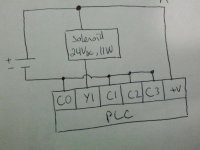Hi,
I'm trying to drive a water solenoid valve (24V, 11W) using an on-board (sinking) output on an Automation Direct D0-06DD1 PLC. The PLC has AC power, and +24V from an external power supply connected to "+V", and C0,C1,C2,C3 connected to 0V on the external power supply. The solenoid is wired with one end on the +24V from the external power supply, and one end to output Y1 on the solenoid. The attached image shows a sketch of the circuit.
The first time I turned on Y1, the solenoid activated as expected. However, when I turned off Y1, the solenoid did not close until I turned off the PLC power. Now, when I turn the PLC back on the solenoid is activated independent of the state of Y1. Additionally, I smelt a faint burning plastic scent, so I'm guessing I burned out the output transistor on the PLC.
Is it possible to drive a solenoid directly from the DL06 DC output, or do I need to do a relay? My application has a lot of on-off cycles for the solenoids, and is deployed off-site, so I'd really rather not use relays due to the limited cycle lifetime. Do I need to put in a shunting diode to account for the spikes of the inductive load of a solenoid?
Thanks,
Justin
View attachment 21225

I'm trying to drive a water solenoid valve (24V, 11W) using an on-board (sinking) output on an Automation Direct D0-06DD1 PLC. The PLC has AC power, and +24V from an external power supply connected to "+V", and C0,C1,C2,C3 connected to 0V on the external power supply. The solenoid is wired with one end on the +24V from the external power supply, and one end to output Y1 on the solenoid. The attached image shows a sketch of the circuit.
The first time I turned on Y1, the solenoid activated as expected. However, when I turned off Y1, the solenoid did not close until I turned off the PLC power. Now, when I turn the PLC back on the solenoid is activated independent of the state of Y1. Additionally, I smelt a faint burning plastic scent, so I'm guessing I burned out the output transistor on the PLC.
Is it possible to drive a solenoid directly from the DL06 DC output, or do I need to do a relay? My application has a lot of on-off cycles for the solenoids, and is deployed off-site, so I'd really rather not use relays due to the limited cycle lifetime. Do I need to put in a shunting diode to account for the spikes of the inductive load of a solenoid?
Thanks,
Justin
View attachment 21225







